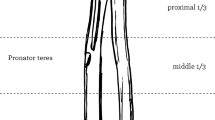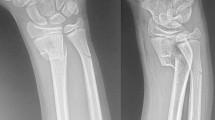Abstract
The aim of our study was to compare the vertical fluoroscopic view of the wrist in extension and supination (ES) to the view in flexion and supination (FS) and determine which of the two views allowed the best visualization of four selected anatomical landmarks SDLR (radial styloid, dorsal radius cortex, Lister’s tubercle and distal radioulnar joint). Our case series included 50 patients who had suffered a distal radius fracture and undergone an open reduction and internal fixation procedure with a volar locking plate. For each case, two fluoroscopic views were taken: ES (wrist extension and supination) (group I) and FS (wrist flexion and supination) (group II). Ten observers had to recognize the SDLR anatomical landmarks on 100 fluoroscopic skyline views (time 1) and 15 days later (time 2). The rate of recognition of the four anatomical landmarks was 78% in group I and 66% in group II (p < 0.001). The concordance rate of recognition of the four anatomical landmarks was mediocre (κ = 0.411). In conclusion, the vertical fluoroscopic skyline view in wrist extension and supination seems to be the most adequate view to assess the quality of the fracture reduction, the distal radioulnar joint and the length of the screws in open reduction and internal fixation of distal radius fractures with volar locking plates.


Similar content being viewed by others
Change history
04 January 2019
The original version of this article unfortunately contained a mistake and has been corrected. First and last names of the author were interchanged. The correct author name is given below.
References
Vaiss L, Ichihara S, Hendricks S, Chihab T, Liverneaux P, Facca S (2014) The utility of the fluoroscopic skyline view during volar locking plate fixation of distal radius fractures. J Wrist Surg 3:245–249
Tang JB, Giddins G (2016) Why and how to report surgeons’ levels of expertise. J Hand Surg Eur 41:365–366
Arora R, Lutz M, Hennerbichler A, Krappinger D, Espen D, Gabl M (2007) Complications following internal fixation of unstable distal radius fracture with a palmar locking-plate. J Orthop Trauma 21:316–322
Benson EC, De Carvalho A, Mikola EA, Veitch JM, Moneim MS (2006) Two potential causes of EPL rupture after distal radius volar plate fixation. Clin Orthop Relat Res 451:218–222
Herrison O, Delaroche C, Maillot-Roy S, Sautet A, Doursounian L, Cambo-Binder A (2017) Comparison of lateral and skyline fluoroscopic views for detection of prominent screws in distal radius fractures plating: results of an ultrasonographic study. Arch Orthop Trauma Surg 137:1357–1362
Vernet P, Durry A, Nicolau X, D’Ambrosio A, Collinet A, Salazar Botero S, Liverneaux P, Hidalgo Diaz JJ (2017) Detection of penetration of the dorsal cortex by epiphyseal screws of distal radius volar plates: anatomical study comparing ultrasound and fluoroscopy. Orthop Traumatol Surg Res 103:911–913
Brunner A, Siebert C, Stieger C, Kastius A, Link B-C, Babst R (2015) The dorsal tangential X-ray view to determine dorsal screw penetration during volar plating of distal radius fractures. J Hand Surg Am 40:27–33
Thomas AD, Greenberg A (2009) Use of fluoroscopy in determining screw overshoot in the dorsal distal radius: a cadaveric study. J Hand Surg Am 34:258–261
Pichler W, Windisch G, Schaffler G, Rienmuller R, Grechenig W (2009) Computer tomography aided 3D analysis of the distal dorsal radius surface and the effects on volar plate osteosynthesis. J Hand Surg Eur 34:598–602
Riddick AP, Hickey B, White SP (2012) Accuracy of the skyline view for detecting dorsal cortical penetration during volar distal radius fixation. J Hand Surg Eur 37:407–441
Smith DW, Henry MH (2004) The 45° pronated oblique view for volar fixed-angle plating of distal radius fractures. J Hand Surg Am 29:703–706
Maschke SD, Evans PJ, Schub D, Drake R, Lawton JN (2007) Radiographic evaluation of dorsal screw penetration after volar fixed-angle plating of the distal radius: a cadaveric study. Hand (N Y) 2:144–150
Jacob J, Clay NR (2009) Re: Pichler et al. Computer tomography aided 3D analysis of the distal dorsal radius surface and the effects on volar plate osteosynthesis. J Hand Surg Eur 34:598–602. J Hand Surg Eur 2010;35:335–336
Joseph J, Harvey JN (2011) The dorsal horizon view: detecting screw protrusion at the distal radius. J Hand Surg Am 36:1691–1693
Dolce D, Goodwin D, Ludwig M, Edwards S (2014) Intraoperative evaluation of dorsal screw prominence after polyaxial volar plate fixation of distal radius fractures utilizing the Hoya view: a cadaveric study. Hand (N Y) 9:511–515
Vaiss L, Ichihara S, Ramirez DGH, Hendricks S, Liverneaux P, Facca S (2015) A comparative study about ionizing radiation emitted during radiological “skyline” view of the wrist in pronation versus supination. Eur J Orthop Surg Traumatol 25:309–311
Klammer G, Dietrich M, Farshad M, Iselin L, Nagy L, Schweizer A (2012) Intraoperative Imaging of the distal radioulnar joint using a modified skyline view. J Hand Surg Am 37:503–508
Ozer K, Toker S (2011) Dorsal tangential view of the wrist to detect screw penetration to the dorsal cortex of the distal radius after volar fixed-angle plating. Hand (N Y) 6:190–193
Haug LC, Glodny B, Delm C, Lutz M, Attal R (2013) A new radiological method to detect dorsally penetrating screws when using volar locking plates in distal radial fractures. The dorsal horizon view. Bone Jt J Br 95:1101–1105
Acknowledgements
François Séverac, Pôle de Santé publique, Secteur méthodologie et Biostatistiques, Hôpitaux Universitaires de Strasbourg, qui a réalisé l’étude statistique.
Author information
Authors and Affiliations
Corresponding author
Ethics declarations
Conflict of interest
Philippe Liverneaux has conflicts of interest with Newclip Technics, Argomedical, Zimmer Biomet and Biomodex. None of the other authors have conflicts of interest.
Rights and permissions
About this article
Cite this article
El Amiri, L., Igeta, Y., Pizza, C. et al. Distal radius fluoroscopic skyline view: extension–supination versus flexion–supination. Eur J Orthop Surg Traumatol 29, 583–590 (2019). https://doi.org/10.1007/s00590-018-2335-3
Received:
Accepted:
Published:
Issue Date:
DOI: https://doi.org/10.1007/s00590-018-2335-3




